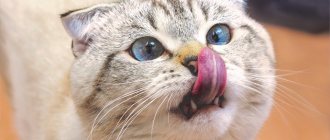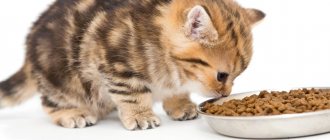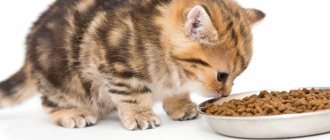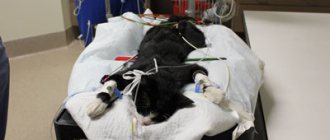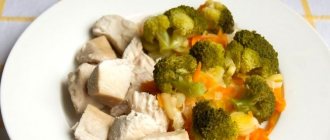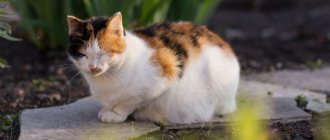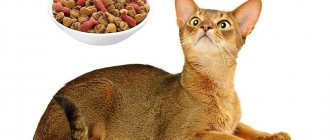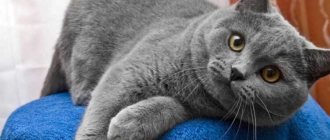When a cat is waiting for a replenishment, you need to try to do everything to make it more comfortable and calm for her to endure her position. Properly balanced food plays an important role for the full intrauterine development of future offspring. That is why a caring owner should know what to feed a pregnant cat, what can be given to her, and what is strictly prohibited. We will devote this article to this issue.
How does feeding affect pregnancy in cats?
A well-fed pregnant cat feels good.
In addition to the metamorphoses that occur with internal organs, metabolism also changes. Initially, there may be an increase in appetite, the absorption of nutrients also increases, which leads to an increase in body weight.
By the end of the gestation period, the animal may lose weight, and if improperly fed, it may even suffer from exhaustion. Errors in the preparation of the diet, when an insufficient amount of nutrients enters the body, will lead to disruption of the formation of the offspring’s bones, internal organs and a general developmental delay.
- With insufficient mineral metabolism, bone tissue does not receive the necessary substances for its structure, which can lead to rickets.
- Violation of salt metabolism affects the condition of the teeth.
- An insufficient amount of vitamins affects the development of the nervous system, the growth of internal organs and leads to developmental defects.
- A lack of amino acids and proteins (the main building material) will even provoke a miscarriage: nature always gets rid of unnecessary ballast that is unadapted to normal life.
That is why feeding should be balanced and varied, and most importantly, complete. This is especially important in the first month after conception, when all the internal systems of the body are being formed.
Breed Features
After studying breed forums, you may come to the conclusion that feeding a pregnant cat is a very complex science. For example, breeders of British and Scottish fold cats advise very strictly controlling the amount of calcium and other trace elements. The reason is the hereditary tendency of the breeds to develop bone defects. Maine Coon breeders recommend switching expectant mothers to kitten food and increasing the daily food intake by no more than 3–4 times. Representatives of the breed are large in size, they have serious nutritional needs, but they also have a tendency to obesity.
Feeding the future mother of a Sphynx is a separate science. Most representatives of this breed suffer from food allergies. The breeder has to find a way out of a very difficult situation - expand the diet, increase its richness and digestibility, and at the same time avoid prohibited foods. Almost all discussions boil down to the fact that the cat needs to be switched to high-quality, hypoallergenic food.
Educational program on some elements
Folic acid . At the beginning of pregnancy (about a couple of weeks after mating) and before conception (at least 3 months), it is a good idea to give your cat folic acid. This connection is actively involved:
- in DNA synthesis and cell division;
- formation of the blood system in future offspring;
- formation of the neural tube and brain of the embryo.
Calcium and phosphorus . Experts also give recommendations on the use of calcium in the diet. Usually it is included only in the second half of pregnancy (by the way, it lasts on average 65 days), and 3 weeks before birth it is excluded from the cat’s menu.
- Excess calcium will provoke the growth of the skull bones and a lag in the development of already born kittens.
- Lack of calcium is the cause of eclampsia in a woman in labor (the appearance of convulsions, fever and even death) and puerperal fever.
As for phosphorus, this element is found in abundance in meat, so when selecting vitamin and mineral supplements, make sure that it is not there. Otherwise, you can get an imbalance in calcium-phosphorus metabolism.
On a note! When using dry food, there is no need to introduce additional vitamins and minerals into the diet for pregnant cats, since everything is already balanced in it.
It is believed that when feeding naturally, additional calcium must be included in the diet to balance out phosphorus: 100 g of meat product should contain 150 mg of calcium. It is better to give it in its natural form, for example, by grinding eggshells into powder.
But trying to feed a pregnant cat with calcium gluconate is a waste of time, since calcium is absorbed by the body only from the carbonate compound. For better absorption of the mineral component, you can use fish oil.
Protein is necessary for the formation of all tissues and is involved in milk production during lactation. With a lack of protein, the animal loses muscle mass.
Taurine is an amino acid. With its deficiency, miscarriage or death of the offspring occurs in the middle of pregnancy, and the birth of underdeveloped and sick kittens is possible.
Fatty acids such as linoleic and arachidonic acids are also important in maintaining pregnancy. If they are deficient, unborn offspring may die, and in the future the cat will become infertile.
Copper and iron are elements that must be present in the diet to prevent the development of anemia, but their excess will lead to constipation.
Basic feeding rules
First trimester . At the beginning of pregnancy, the cat's appetite increases significantly, which is why the total amount of food needs to be increased.
In the first two weeks after fertilization, the diet must be increased by 10% of the standard. At the same time, it is not the single serving that is increased, but the number of meals. On average, an animal should eat 4-5 times a day.
Second trimester . After the third week, the amount of food per day is increased by another half of the norm. At the same time, you should not follow the cat’s lead and feed it every time it starts begging for a tidbit. Overeating, like starvation, negatively affects the course of pregnancy itself and the development of kittens.
- Excessive nutrition will lead to obesity, but it is not a fact that the excess will go specifically to the kids.
- Fat deposition in internal organs, including the uterus, will significantly complicate the course of labor due to poor contractility of smooth muscles and its atony.
On a note! Ideally, the animal after birth should weigh the same as it weighed before conception.
Third trimester. At the end of pregnancy, appetite decreases due to the increasing pressure of the fetus on the stomach. In order not to overload the digestive system, the volume of food is maintained, but the number of feedings can be increased up to 6 times a day.
Just before the birth (about a week in advance), it is better to unload the intestines, and the kittens no longer need nutrition so much, so the diet is reduced to the standard (pre-pregnancy) norm. The animal is fed 3 times a day.
If a pregnant woman refuses to eat at all, you should not force-feed her, much less worry - most likely, her finest hour is approaching and labor is about to begin.
Possible difficulties
Despite the naturalness of the process, veterinarians recommend not to relax and be alert. This will help you not get confused and provide timely assistance if difficulties arise.
False pregnancy
This disorder is not an independent pathology, but increases the likelihood of developing cancer and inflammatory diseases of the reproductive system. Symptoms of a false pregnancy are similar to a real one. Because of this, it cannot be diagnosed without a blood test, ultrasound and x-ray.
Hormonal drugs are used to treat pseudopregnancy. If there is no effect from their use, the animal is sterilized and excluded from breeding.
“ More about false pregnancy in cats
Non-viable fruits
There are two options here: miscarriage and resorption, that is, spontaneous resorption of the fetus. Both pathologies are usually observed approximately 28-35 days after conception.
The non-viability of the fruit can be determined by the following symptoms:
- atypical discharge from the vulva;
- refusal to eat, vomiting and dehydration;
- temperature drop;
- pain in the abdomen, accompanied by a plaintive meow.
An accurate diagnosis can ONLY be established using ultrasound. If residual fragments are found in the uterus, an operation is performed to remove them.
Infection during pregnancy
Most viral, bacterial and parasitic infections are transmitted through the placenta. Infected cubs usually die in the womb or a few days after birth.
The most effective ways to prevent infection are vaccination and deworming. Additional recommendations include a strict ban on walking outside and safe storage of outdoor shoes and clothing.
Psychological abnormalities
In the worst case, after the kittens are born, the cat may refuse to raise them - and even try to kill them. This atypical behavior is most often explained by the following reasons:
- too early conception (before the third heat);
- the presence of mastitis, eclampsia or other postpartum complications;
- non-viability of the cubs (instinct prompts to get rid of the weakest);
- lack of milk or too many offspring;
- severe stress;
- physical weakness due to poor nutrition.
An apathetic or aggressive animal must be shown to a veterinarian, and then act according to the circumstances. Thanks to the achievements of modern veterinary medicine, weak babies can be taken out, so don’t give up and follow the instructions you receive.
Approximate diet from “natural”
Meat should be present in the diet of a pregnant cat.
When compiling a diet, it is necessary to take into account a variety of factors:
- age,
- breed,
- size.
But regardless of this, the animal must be provided with all the necessary nutrients:
- protein;
- carbohydrates;
- lipids;
- macro- and microelements, vitamins.
Meat ingredients . At the top of the cat food pyramid is meat (beef, chicken, turkey, offal). It is the main source of proteins - the main building material of any living organism.
It is better to serve beef raw, but first cut it into portions and keep it in the freezer for 2 weeks - this will kill germs and worms.
Fish products . Many experts do not recommend feeding a cat fish during pregnancy, but sometimes your pet (no more than once every 10 days) can be pampered with a boiled delicacy, especially if the animal needs it.
They never offer raw fish - the risk of catching liver flukes is too great. This is an unpleasant phenomenon in ordinary life, but during pregnancy it is even worse: the worms will not only draw all the beneficial substances from food and release toxins into the blood, but will also cause disturbances in the functioning of the liver and intestines.
Milk is also a protein, as well as vitamins, but in many animals it causes digestive system upset, so it is better to avoid it. A good alternative would be cottage cheese or yogurt. By the way, these products are an excellent source of natural calcium, which is necessary for the formation of the skeletal system, teeth, and claws.
But it is worth remembering that excess calcium will lead to constipation, impaired kidney function, cardiac function, and can even cause calcification of the membranes, which will create certain difficulties during childbirth.
Approximate ratio of foods in the diet for a cat weighing up to 3 kg:
- beef (chicken, turkey) – 110-160 g (up to 180-200 g in mid-pregnancy);
- cottage cheese, fermented milk products – up to 50 g;
- vegetables – 60 g (up to 80 g in mid-pregnancy);
- egg (yolk, not white), fish - no more than once a week.
On the recommendation of a veterinarian, mineral supplements and vitamins are included in the diet.
Some experts advise giving cats cereal porridge. It is not clear how justified this is, but in small quantities and not often they will not hurt. If you think logically, then when living in natural conditions, cereals enter the cat’s body with the same rodents or birds that they hunt.
Helpful feeding tips:
- For constipation, which often occurs during pregnancy, be sure to flavor the food with vegetable oil.
- So that the expectant mother eats vegetables with pleasure, they are chopped and added to the meat puree.
- At the end of pregnancy, a decoction of nettle is added - it improves milk production.
- Raspberry decoction throughout pregnancy makes labor easier.
Feeding with prepared food
Dry food for a pregnant cat should be of high quality.
In principle, the animal can be fed with ready-made “drying”, especially if it is accustomed to it. But in this case, they focus on food specially created for such an interesting situation. It is very important to use only high-class products in your diet - no less than premium.
It is clear that ready-made food is a convenient invention and does not require any effort from the owner at all:
- no mental ones - everything has already been thought out and compiled for you;
- neither physical - I poured it in and forgot.
But you still have to strain:
- firstly, not all food is suitable for a particular animal, and trying to change something during pregnancy is fraught with problems: allergies, digestive disorders and even miscarriage;
- secondly, it is necessary to study the composition of the finished menu and draw a conclusion from it about the quality of the ingredients and their health benefits;
- thirdly, the food is poured not from a lantern, but strictly following the instructions and standards indicated on the packaging: both a lack and an excess of nutrients will lead to negative consequences;
- fourthly, about changing the food: if your company does not produce products for pregnant women, then there is no need to change anything. It is better to try to calculate the portion of your usual food for a specific period of pregnancy (at least simply increase the standard daily dose by the same 10% or 50%). This will be much more rational than looking for something new and conducting unjustified experiments. Why? See point one!
About taste perversions in pregnant cats
Just like people, pregnant cats may become more sensitive to foods that they would never have thought to react to before. Grapes, apples, carrots, olives are not the strangest things your cat can eat while pregnant. And while some foods are perfectly acceptable in reasonable quantities, others can cause significant harm. Be careful! No chocolate, groceries, nuts, onions, garlic.
Pica may also occur - the desire to chew inedible things, such as woolen products, plastic bags, lime, brooms, etc. If you notice such a reaction, do not scold your pet, this is normal, just remove dangerous objects away.
Let your cat be healthy, happy and make you happy with wonderful kittens, all for mom!
What should you not give?
There are some cat owners who like to pamper their pets with tasty morsels from the common table: they may be very tasty, but they are not entirely healthy (in some cases, even for the person himself).
Therefore, all human nasty things are not given to a pregnant animal. This rule especially applies to:
- all types of cheap sausage, where the only meat present is “gulkin’s nose”;
- salted-smoked foods;
- everything that may contain “chemistry”.
Dry or wet?
Veterinarians do not advise suddenly changing your animal’s usual feeding pattern - this will help avoid unnecessary stress both for him and for you. The main thing here is to avoid sudden and unexpected changes for your pet.
If you previously fed your cat dry kibble, continue doing so. If you sometimes added wet canned food or pouches to your dry diet, do not change your usual approach. The same applies to a completely natural diet - if the animal is accustomed to it, then leave everything as is, just review the ratio of nutrients and add special vitamin and mineral complexes for pregnant animals.
